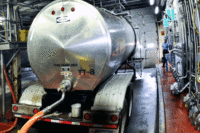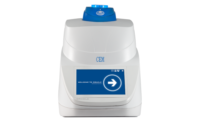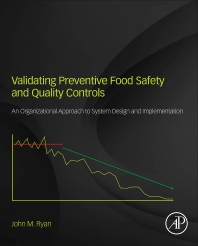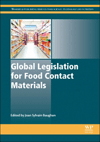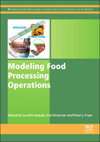Equipment, lab tests, employee training contribute to food safety
Go beyond HACCP plans and GMPs to assure that dairy foods are manufactured safely. Take advantage of advances in CIP technology, detection devices and environmental air samplers.

X-ray inspection systems assure a high level of food safety. Photo courtesy of Mettler- Toledo Safeline.

Test for food pathogens. Photo courtesy of Bio-Rad laboratories.


Ensuring compliance with food safety standards in an increasingly complex regulatory environment can be challenging for dairy processors. To meet current state and national safety standards, dairy product manufacturers use plant-wide Hazard Analysis and Critical Control Point (HACCP) plans. These plans provide individualized standards for good manufacturing practices (GMP) based on the U.S. Food and Drug Administration’s (FDA) requirements.
Comprehensive HACCP plans also lay out flexible, organized procedures to enhance product safety and reduce product recalls from the marketplace. An effective HACCP plan can also help dairy manufacturers increase efficiency and lower costs throughout their operations.
In addition to HACCP, rigorous line maintenance and comprehensive food quality programs, replacing or modifying older machinery can help dairy processors boost productivity and gain a competitive edge, while instilling greater consumer confidence in their brands.
More efficient cleaning
Industry groups such as 3-A Sanitary Standards Inc. promote food safety and public health by helping manufacturers source advanced hygienic equipment, including clean-in-place (CIP) technology. CIP systems play an increasingly important role in dairy plants, helping to augment food safety measures by shortening sanitation times, governing the flow of cleaning solutions, increasing plant productivity and lowering labor costs.
Advances in CIP technologies enable shorter change-over and cleanup time, while meeting and exceeding the highest food safety standards. For example, new technology is constructed to be more durable and able to withstand higher tolerances, which prevents debris buildup and streamlines the cleaning process.
Mechanical components such as versatile frame sections and other tool-less components are also being installed in dairy plant machinery to help engineers quickly complete tasks and make cleaning easier and more efficient.
Testing for pathogens
Dairy processors are required by law to routinely test for plant pathogens and bacteria. The list of pathogens includes Salmonella, Listeria monocytogenes and Cronobacter species. In some instances, identification of reoccurring pathogens collected from multiple environmental samples can lead to product contamination and ultimately, costly recalls.
New pathogen sampling technologies can make testing easier for plant engineers, thereby increasing efficiency without sacrificing accuracy. Additionally, operators will no longer need to adjust their protocols for individual types of pathogens; one device is capable of handling all samples.
In addition to testing for pathogens and bacteria, new proactive air sampling technologies in dairy plants are helping engineers detect viable airborne particles and establish baseline data for typical microbes found. For example, advancements in precision air sampling technologies now allow the unit volume of air to be quantified, allowing for easier contaminant identification.
Another way dairy processors can increase assurance of product quality is through the use of tabletop texture analyzers. These compact devices obtain objective, numerical results that can support environmental sensory testing in quality control programs. Further enhancing plant safety, these analyzers feature high-speed data sampling, wide-area testing and improved software for easier operation.
Metal detectors, NIR analyzers
Metal detection and near infrared (NIR) technologies provide another level of quality assurance and safety for dairy plants.
Advanced metal detectors can identify particles as small as 0.5 millimeters in diameter, further bolstering a facility’s safety operating standards. These machines also collect data much more efficiently, allowing for the use of lower-wattage generators which produce less heat and lower operating costs.
Accurate NIR analyzers deliver more consistent dairy product standardization by testing a variety of parameters simultaneously, including product moisture, protein and acidity. High quality in-line NIR analyzers and built-in software allow for simultaneous calibration and automated, real-time process control for multiple product runs. These systems help reduce waste and support a facility’s safety standards through increased accuracy and productivity.
While safe packaging and processing machinery are important to plant operations, manufacturers are seeking the expertise of their supply partners for guidance on food safety standards. Maintaining a strong relationship and keeping an open dialogue with suppliers from the beginning of a project will not only increase plant efficiency, but help manufacturers meet the industry’s strict regulatory requirements.
Find answers at Pack Expo
To help dairy manufacturers better navigate the regulatory environment and plan for new and pending standards with successful safety programs, PACK EXPO International 2014 (Nov. 2 to 5 at McCormick Place in Chicago) will feature a wide range of processing and packaging technologies for the industry.
The Processing Zone section will provide solutions for a unified approach to packaging and processing for the entire manufacturing line. The Food Safety Summit Resource Center, sponsored by the Food Safety Summit (produced by Dairy Foods’ owner BNP Media), will bring together subject-matter experts to speak about developments in the Food Safety Modernization Act, FDA regulations and other important food safety issues targeting packaging, HACCP, sanitation and more. More information is online at www.packexpointernational.com.
Looking for a reprint of this article?
From high-res PDFs to custom plaques, order your copy today!





